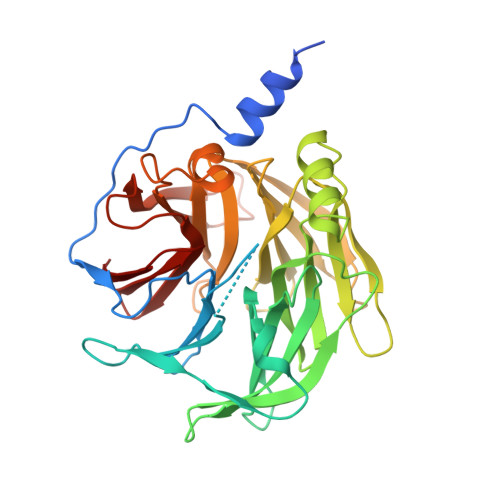Catalytic versatility and backups in enzyme active sites: the case of serum paraoxonase 1.
Ben-David, M., Elias, M., Filippi, J.J., Dunach, E., Silman, I., Sussman, J.L., Tawfik, D.S.(2012) J Mol Biol 418: 181-196
- PubMed: 22387469
- DOI: https://doi.org/10.1016/j.jmb.2012.02.042
- Primary Citation of Related Structures:
3SRE, 3SRG - PubMed Abstract:
The origins of enzyme specificity are well established. However, the molecular details underlying the ability of a single active site to promiscuously bind different substrates and catalyze different reactions remain largely unknown. To better understand the molecular basis of enzyme promiscuity, we studied the mammalian serum paraoxonase 1 (PON1) whose native substrates are lipophilic lactones. We describe the crystal structures of PON1 at a catalytically relevant pH and of its complex with a lactone analogue. The various PON1 structures and the analysis of active-site mutants guided the generation of docking models of the various substrates and their reaction intermediates. The models suggest that promiscuity is driven by coincidental overlaps between the reactive intermediate for the native lactonase reaction and the ground and/or intermediate states of the promiscuous reactions. This overlap is also enabled by different active-site conformations: the lactonase activity utilizes one active-site conformation whereas the promiscuous phosphotriesterase activity utilizes another. The hydrolysis of phosphotriesters, and of the aromatic lactone dihydrocoumarin, is also driven by an alternative catalytic mode that uses only a subset of the active-site residues utilized for lactone hydrolysis. Indeed, PON1's active site shows a remarkable level of networking and versatility whereby multiple residues share the same task and individual active-site residues perform multiple tasks (e.g., binding the catalytic calcium and activating the hydrolytic water). Overall, the coexistence of multiple conformations and alternative catalytic modes within the same active site underlines PON1's promiscuity and evolutionary potential.
Organizational Affiliation:
Department of Structural Biology, Weizmann Institute of Science, Rehovot 76100, Israel.


















